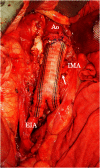Surgical Complications after Open Abdominal Aortic Aneurysm Repair: Intestinal Ischemia, Buttock Claudication and Sexual Dysfunction
- PMID: 31275467
- PMCID: PMC6600101
- DOI: 10.3400/avd.ra.19-00038
Surgical Complications after Open Abdominal Aortic Aneurysm Repair: Intestinal Ischemia, Buttock Claudication and Sexual Dysfunction
Abstract
While surgical treatment for abdominal aortic aneurysm (AAA) is a standard operation, prevention of complication is important. Intestinal ischemia of the sigmoid colon and/or rectum after AAA surgery is severe and has a high mortality rate although occurrence frequency is low. The most important thing to prevent is the preoperative and intraoperative evaluation of the left hemicolon and rectal circulation. Measurement of inferior mesenteric artery stump pressure is also useful. From the viewpoint of prevention of buttock claudication, it is desirable that internal iliac artery (IIA) blood flow is preserved, but aggressive IIA reconstruction adaptation is considered to be low. For erectile function, it is important that the antegrade blood flow from the IIA to the internal pudendal artery on at least one side is preserved or reconstructed. To prevent retrograde ejaculation, it is important to preserve the superior hypogastric plexus and one side of the lumbar splanchnic nerve, and the hypogastric nerve. Understanding and mastering local anatomy and pathophysiology is important in preventing complications, and we must also remember that we always keep watchful surgical operations in mind in order to prevent tissue damage. (This is a translation of Jpn J Vasc Surg 2019; 28: 99-103.).
Keywords: abdominal aortic aneurysm; buttock claudication; intestinal ischemia; sexual dysfunction.
Conflict of interest statement
Disclosure StatementThe author does not have any conflict of interest related to this article.
Figures




Similar articles
-
Prevention and management of sigmoid and pelvic ischemia associated with aortic surgery.Semin Vasc Surg. 2001 Dec;14(4):255-65. doi: 10.1053/svas.2001.27891. Semin Vasc Surg. 2001. PMID: 11740833 Review.
-
Outcomes of Extended Endovascular Aortic Repair for Aorto-Iliac Aneurysm with Internal Iliac Artery Occlusion.Ann Vasc Dis. 2017 Dec 25;10(4):359-363. doi: 10.3400/avd.oa.17-00089. Ann Vasc Dis. 2017. PMID: 29515696 Free PMC article.
-
Preservation of pelvic circulation with hypogastric artery bypass in endovascular repair of abdominal aortic aneurysm with bilateral iliac artery aneurysms.J Vasc Surg. 2006 Dec;44(6):1170-5. doi: 10.1016/j.jvs.2006.08.011. J Vasc Surg. 2006. PMID: 17145417 Clinical Trial.
-
Hybrid Endovascular Aortic Aneurysm Repair: Preservation of Pelvic Perfusion with External to Internal Iliac Artery Bypass.Ann Vasc Surg. 2017 Jul;42:162-168. doi: 10.1016/j.avsg.2016.10.052. Epub 2017 Mar 8. Ann Vasc Surg. 2017. PMID: 28286187 Free PMC article.
-
Buttock claudication and erectile dysfunction after internal iliac artery embolization in patients prior to endovascular aortic aneurysm repair.Cardiovasc Intervent Radiol. 2008 Jul-Aug;31(4):728-34. doi: 10.1007/s00270-008-9319-3. Epub 2008 Mar 13. Cardiovasc Intervent Radiol. 2008. PMID: 18338212 Review.
Cited by
-
[Cryopreservation of human spermatozoa or testicular tissue for fertility preservation].Urologie. 2024 Nov;63(11):1089-1096. doi: 10.1007/s00120-024-02456-7. Epub 2024 Oct 23. Urologie. 2024. PMID: 39441429 German.
-
IFABP levels predict visceral malperfusion in the first hours after open thoracoabdominal aortic repair.Front Cardiovasc Med. 2023 Jun 27;10:1200967. doi: 10.3389/fcvm.2023.1200967. eCollection 2023. Front Cardiovasc Med. 2023. PMID: 37441698 Free PMC article.
-
Sexual dysfunction after open abdominal aortic aneurysm repair: 16 years' experience in a quaternary center and literature review.J Vasc Bras. 2024 Feb 5;23:e20230135. doi: 10.1590/1677-5449.202301352. eCollection 2024. J Vasc Bras. 2024. PMID: 38433984 Free PMC article.
-
HE4 as a Prognostic Biomarker of Major Adverse Cardiovascular Events in Patients with Abdominal Aortic Aneurysm: A Canadian Prospective Observational Study.Biomedicines. 2025 Jun 26;13(7):1562. doi: 10.3390/biomedicines13071562. Biomedicines. 2025. PMID: 40722638 Free PMC article.
-
A Cadaveric Case Study on the Abdomen: A Temple of Surprises.Cureus. 2024 Oct 16;16(10):e71618. doi: 10.7759/cureus.71618. eCollection 2024 Oct. Cureus. 2024. PMID: 39553026 Free PMC article.
References
-
- Björck M, Troëng T, Bergqvist D. Risk factors for intestinal ischaemia after aortoiliac surgery: a combined cohort and case-control study of 2824 operations. Eur J Vasc Endovasc Surg 1997; 13: 531-9. - PubMed
-
- Brewster DC, Franklin DP, Cambria RP, et al. Intestinal ischemia complicating abdominal aortic surgery. Surgery 1991; 109: 447-54. - PubMed
-
- Goldstone J. Aneurysm of the aorta and iliac arteries. In: Moore WS ed. Vascular and Endovascular Surgery, 8th ed. Philadelphia: Elsevier Saunders, 2013: 651-75.
-
- Woo EY, Damrauer SM. Abdominal aortic aneurysms: open surgical treatment. In: Cronenwett JL and Johnston KW eds. Rutherford’s Vascular Surgery, 8th ed. Philadelphia: Elsevier Saunders, 2014: 2024-45.

